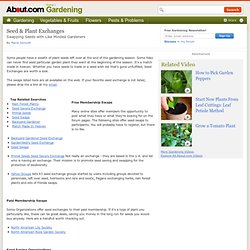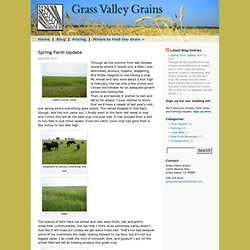

Seed Exchanges - Swapping Seeds with Like Minded Gardeners. Some people have a wealth of plant seeds left over at the end of the gardening season.

Some folks can never find seed particular garden plant they want at the beginning of the season. It's a match made in heaven. Whether you have seeds to trade or a seed wish list that's gone unfulfilled, Seed Exchanges are worth a look. The swaps listed here are all available on the web. If your favorite seed exchange is not listed, please drop me a line at my email. Free Membership Swaps Many online sites offer members the opportunity to post what they have or what they're looking for on the forum pages. Paid Membership Swaps Some Organizations offer seed exchanges to their paid membership. Seed Saving Organizations Finally some organizations are completely devoted to saving and exchanging seed. If there's a horticultural society, arboretum or public garden you particularly love, be sure to check into how you can get on their seed exchange list.
Links page. Soil Association : Home. Plants For A Future : 7000 Edible, Medicinal & Useful Plants. Seed Savers Exchange. Living and Raw Foods Community Support. Blog « Grass Valley Grains. One of the puzzles I have been pondering the last three years of my grain operation is how to affordably and sustainably fertilize and manage an organic crop.

Non-organic seed and fertilizer are cheaper, you can use chemicals to control weeds and pests, and the record-keeping is simpler. I am convinced, though, that petroleum based fertilizers are unsustainable for society and that endless use of chemicals is destroying the soil and the environment. My first year of farming grain I didn’t have time to do anything but buy fertilizer so I bought the amount the rep suggested. I got a pretty good crop but the cost was astronomical and certainly not feasible for the selling price of the finished grain. I tried to grow a berseem clover cover crop but it failed miserably because there wasn’t any rain for quite some time after I seeded and then it was cold so the clover didn’t grow.
This fall I got that same soil tested and found that pretty much everything except manganese was still very low. Building Fertile Soil. Composting Humanure Humanure management for maximum nutrient secuestration and minimum resource loss.

Building fertile soil means learning how to feed the soil to feed the plants. It's a fundamental axiom of organic gardening and farming, and once you understand what "feeding the soil" means to building fertile soil, you'll also understand why organic methods, and no-till techniques in particular, work so well. Even though you can't see most of it, a complex soil food web lives in your garden; it's teeming with earthworms, mites, bacteria, fungi — all kinds of mostly microscopic, interdependent organisms that release mineral nutrients and create the loose soil structure crops need to thrive. Beneficial mycorrhizal fungi (see "The Magic of Mycorrhizal Fungi," page 24 in this issue) grow in and around plant roots, mining subsoil for nutrients and water to share with your crops.
Your crops actually help feed all this underground life. First, minimize plowing, tilling and digging. Sprouting Instructions and Sprouting Chart - The Easy Way.